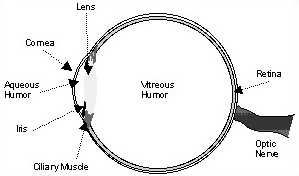The Eye
The eye is a sophisticated, one-lens system for imaging visible light. Light passes through the cornea, through the iris, into the anterior chamber that is filled with a water-based fluid called the aqueous humor, through the lens, into another water-based fluid called the vitreous humor, and finally onto the retina. The iris is an opaque aperture that limits the amount of light that enters the eye. The lens is a tough membrane that is filled with long cells. The focal length (power) of the lens is changed when the ciliary muscle forces the lens to change shape. This enables us to image objects at different distances.

Representation of the eye
A person’s eyesight changes as he or she ages because the cells of the lens multiply, but the membrane that surrounds them won’t allow any to escape. As the cells in the lens become more dense, the index of refraction of the lens changes and the lens can’t be bent as well by the ciliary muscle.
The eye is a wonderful system, but it frequently suffers from one of two refractive errors: myopia (nearsightedness) and hyperopia (farsightedness). In the case of myopia, the eye forms an images of distant objects in front of the retina, which makes those objects seen as being of focus. The eye is able to form images on the retina for objects that are closer than the eye’s far point. Myopia can be accommodated for through the use of a negative lens that will cause the light rays to diverge. The power of the lens is chosen by matching the lens’ focal point with the eye’s far point. This causes the light rays to diverge by the correct amount, so that the images of distant objects coincide with the location of the retina.

A myopic eye

Use of a Negative Lens to Correct for Myopia
In the case of hyperopia, light from distant objects is focused to a point behind the retina. In this case, the eye can image rays that would naturally converge to a point to the right of the retina, if the eye did not act to image them. The point to which the least converging rays that the eye can still image come to a focus defines the far point a hyperopic eye. A positive lens, which has a focal length that coincides with the far point of the eye, can be used to correct for farsightedness.

A hyperopic eye

Use of a positive lens to correct for hyperopia









